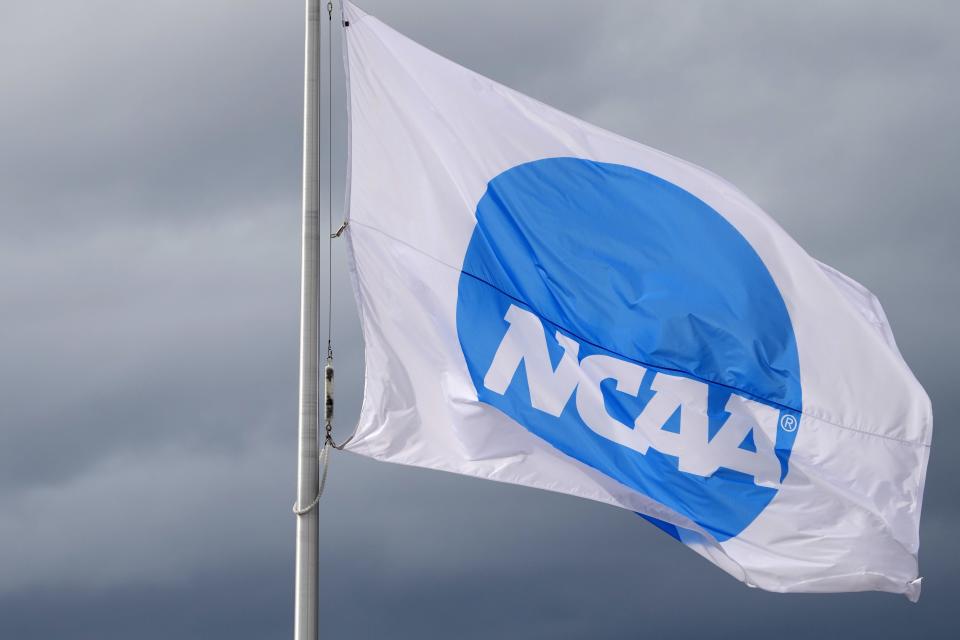Name, image and likeness lawsuit targets college sports TV revenue dating back to 2016
Attorneys for the plaintiffs in a lawsuit against the NCAA and the nation’s top college conferences that challenges the association’s remaining rules regarding athletes’ ability to make money from their names, images and likenesses reiterated in a filing Friday night that athletes are entitled to a share of the billions of dollars in college sports TV revenue not only now, but also reaching back to 2016.
The filing seeks to have the suit certified as a class action, meaning it would be applicable to thousands of athletes rather than only the named plaintiffs, Arizona State men’s swimmer Grant House; Oregon women’s basketball player Sedona Prince, who gained renown by drawing attention to disparities in the treatment of athletes in the NCAA men’s and women’s basketball tournaments; and former Illinois football player Tymir Oliver.
Friday night’s submission was partially redacted, and underlying expert reports were filed under seal. But it made clear that the plaintiffs are seeking what would likely be hundreds of millions of dollars in damages.
The largest shares of the damages are being sought for all current and former athletes in football, men’s basketball and women’s basketball who have received full athletic scholarships and play, or have played for a school in one of the Power Five conferences since June 15, 2016. That date is four years prior to when the suit was initially filed, the reach-back period allowed under antitrust law.

NEVER MISS A MOMENT: Follow our sports newsletter for daily updates
Damages also are being sought for athletes in all other NCAA Division I sports who were playing before July 1, 2021 and have been paid for the use of their name, image and likeness (NIL) since that date, which was when the NCAA’s substantially loosened NIL rules went into effect.
The case follows the legal trail carved by the O’Bannon and Alston cases, the latter of which ended with the NCAA losing a unanimous verdict before the Supreme Court. The plaintiffs’ lawyers in this suit are among those who were involved in either or both of the earlier cases, led by Steve Berman and Jeff Kessler. (Kessler argued for the Alston plaintiffs before the Supreme Court.) And this case currently is pending before U.S. District Judge Claudia Wilken, who presided over the early phases of the O’Bannon and Alston proceedings.
The O’Bannon and Alston cases sought injunctions that would change the NCAA’s rules, just as this case does. Those portions of the cases went to trial. The O’Bannon and Alston cases also included damages claims that were settled. The O’Bannon settlement was for about $60 million and connected to use of athletes’ NIL in video games. The Alston was settlement was for about $208 million and based on the difference in the value of a traditional athletic scholarship and one that covered the full cost of attendance.
Because the current case targets TV revenue, the money involved likely would be even greater. The NCAA and the conferences have until April 14, 2023 to respond to Friday night’s filing.
In the filing, the plaintiffs’ lawyers wrote: “The continuing restrictions of the (NCAA’s current NIL rules), including those that prohibit conferences and schools from compensating college athletes for the use of their NILs in broadcasts or otherwise, deprive college athletes of substantial NIL opportunities and compensation.”
They added that absent these restrictions, “at the very least, Power Five football (plus Notre Dame) and men’s and women’s basketball players would have been paid for the use of their NILs in broadcasts.”
The plaintiffs’ TV industry expert Ed Desser has concluded that the athletes’ NIL’s “conservatively constitute” a percentage of the “total economic value” of the TV rights fees paid to the Power Five conferences and Notre Dame, they wrote. That percentage was redacted.
In addition, they said their sports economics expert Dan Rascher has concluded that absent NCAA restrictions, recruiting competition for these athletes would have resulted in the athletes being paid for “the full economic value of their NIL rights in broadcasts.” They wrote that Rascher can show “how the Power Five Conferences and Notre Dame would pay for such rights, in equal shares, through a group license negotiation prior to or at the same time that (an athlete) commits to the school.”
According to the filing, Rascher has found that there are more than 7,000 athletes in football, men’s basketball or women’s basketball who would be entitled to damages.
The damages to athletes in other sports would be based on the value of NIL deals that the plaintiffs argue they would have received, absent the NCAA’s prior restrictions on NIL activity.
In declarations filed Friday night, House said that since the NCAA rules change on NIL, he has been involved in “paid promotional campaigns for numerous companies including HBO, Beine Wellness Building, and Wyman’s Fruit.” Prince said she had been involved with “paid social media promotional campaigns for numerous major companies including Crocs, Butterfinger, H&R Block, Dick’s Sporting Goods, Pepsi, Pape Machinery, and DirecTV.” She also said she had created and marketed her own line of merchandise and apparel that is currently available for sale through the University of Oregon Duck Store.
This article originally appeared on USA TODAY: Name, image, likeness lawsuit targets TV revenue dating back to 2016

